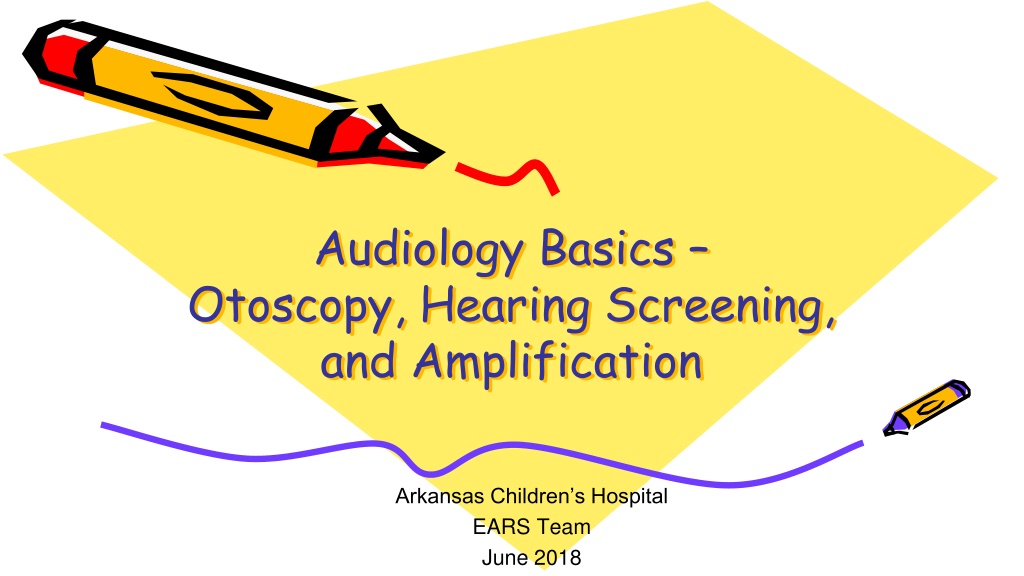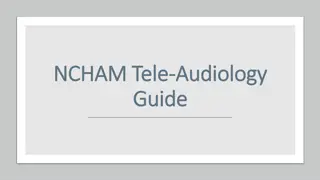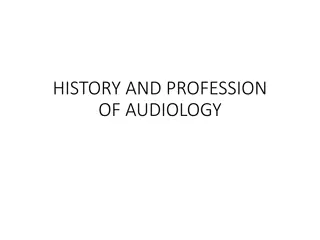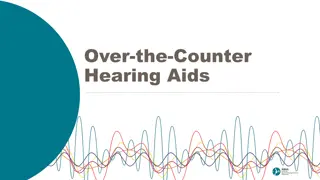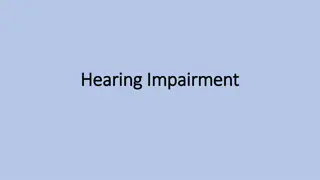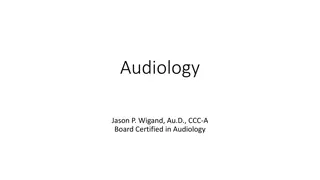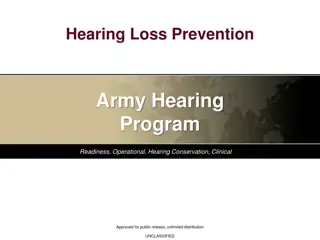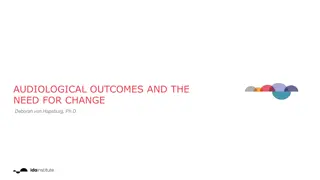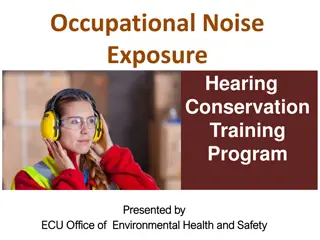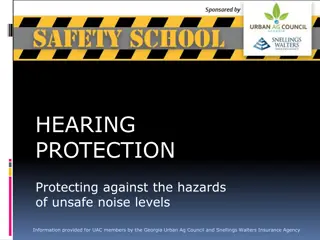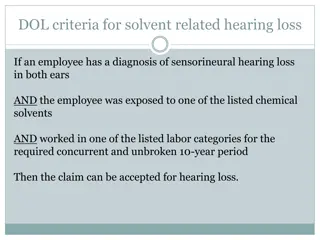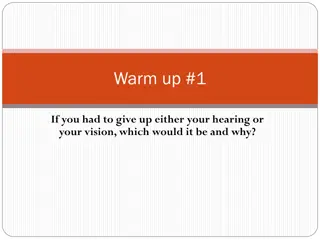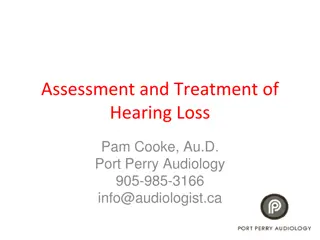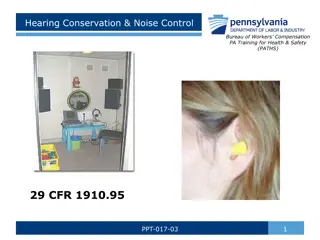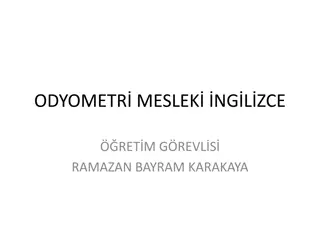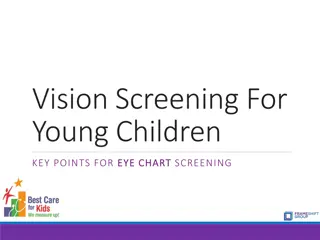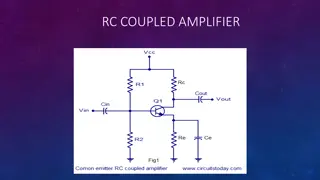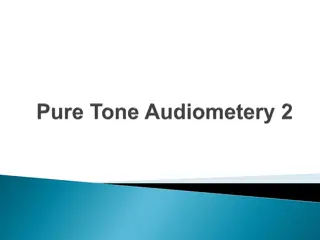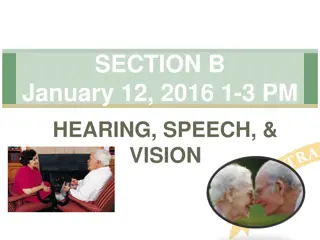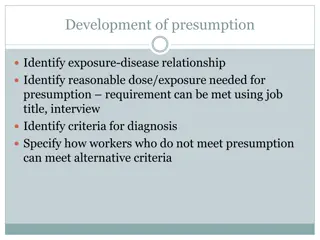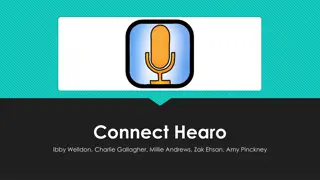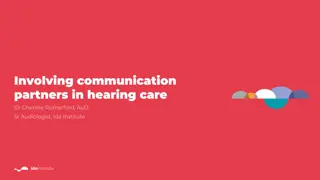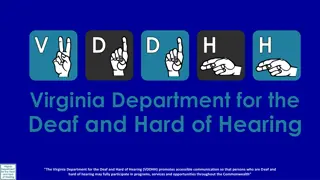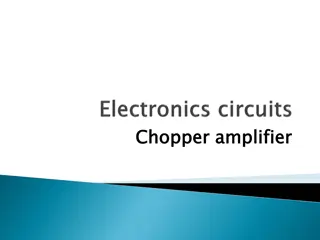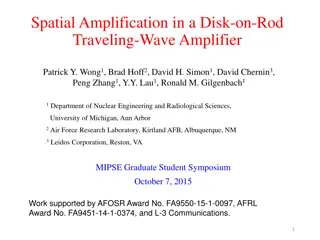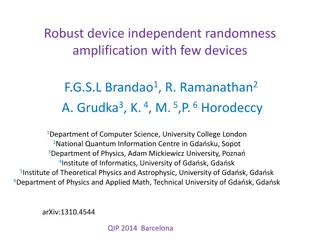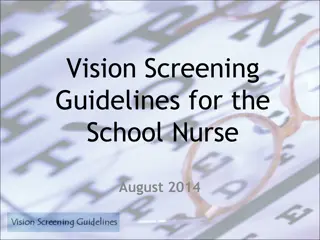Audiology Basics: Otoscopy, Hearing Screening & Amplification Overview
Learn about audiology basics including otoscopy, hearing screening, and amplification. Find out about the learner outcomes, pure-tone testing protocols, who to screen, who not to screen, when to screen, and how to prepare for screenings. Get insights into the essential aspects of audiometry controls and equipment. Enhance your knowledge to perform a hearing screening, troubleshoot amplification issues, recognize otoscopic findings for referrals, and conduct otoscopy effectively.
Download Presentation

Please find below an Image/Link to download the presentation.
The content on the website is provided AS IS for your information and personal use only. It may not be sold, licensed, or shared on other websites without obtaining consent from the author. Download presentation by click this link. If you encounter any issues during the download, it is possible that the publisher has removed the file from their server.
E N D
Presentation Transcript
Audiology Basics Otoscopy, Hearing Screening, and Amplification Arkansas Children s Hospital EARS Team June 2018
Todays Presenters Jessica Newman, Au.D., CCC-A Arkansas Children's Hospital EARS Team NewmanJL@archildrens.org Darby Jackson, Au.D., CCC-A Arkansas Children s Hospital EARS Team JacksonDL2@archildrens.org
Learner Outcomes Perform a hearing screening Complete basic troubleshooting for various types of amplification Recognize otoscopic findings which deem a referral Perform otoscopy
Protocol Summary Pure Tone Screening Rescreening (if did not pass 1stscreen) Referral Follow-up Reporting
Who to Screen Students in grades Pre-K, K, 1, 2, 4, 6, 8 & transfer students Special education students & teacher referrals
Who NOT to Screen Students who wear hearing aids, who have cochlear implants or have documented hearing loss (by an audiologist/MD) should NOT be screened Remember To: Request documentation of a current audiogram (should have annual hearing exam results on file)
When to Screen NOT the first week of school Children entering school for the first time Need time to adjust to school environment BUT you do not want to wait too long if a child DOES have hearing loss Don t wait too long Cold and Flu season Need time for follow-up
Preparing for Screens Know your equipment (Audiometer Controls) Power (on/off) Ear indicator (right/left) Intensity selector (dB; e.g. 20 dB HL) Frequency selector (Hz; e.g. 4000 Hz) Signal selector (use continuous or pulsed tone only) Presentation function (how you present the tone) Annual Calibration (Summertime)
Headphone Placement Place the headphones on student (red on right ear; blue on left ear) Hair behind ears Remove large earrings May want to remove glasses Diaphragm of headphones over ear canal Adjust head band for snug, even fit Head band on top of head is preferred
How to Screen Instruct student for the task (e.g. raise hand when they hear the beep) Condition the student to the task (i.e. present a tone in one ear at one frequency ABOVE the screening level example: 50 dB) Once the student is conditioned start the screening protocol @ 20 dB HL
Screening/Rescreening Protocol Right Ear 1000 Hz 2000 Hz 4000 Hz 1000 Hz 2000 Hz 4000 Hz 20 dB 20 dB 20 dB 20 dB 20 dB 20 dB Left Ear NOTE: Need to obtain 2 responses in each ear at each frequency for a pass
Pass/Fail Criteria Student must pass all frequencies in an ear for that ear to be classified as a pass If a student does not pass ALL frequencies in each ear, he/she should be re-screened in 2-4 weeks 25 dB is NOT a PASS!
Tips and Tricks for Performing Hearing Screenings
Dos DO find a quiet room DO screen at 20 dB HL DO present tone for at least 3 seconds DO use pulsed tones if possible
Donts Don t require students to raise right or left hand Don t get into a pattern with your presentation of the tone Don t give visual cues-position audiometer controls out of view
Donts Don t screen ear with known hearing loss Don t switch the headphones from one audiometer to another. This changes the calibration for your machine. If you have to get your headphones repaired or replaced, your audiometer has to be re-calibrated
Play Audiometry Use with students who are difficult-to-test, who are developmentally delayed, or who are non-English speaking Use a play task (drop blocks in a bucket) Teach child the task at an elevated intensity level (e.g. 50 dB HL) Make sure child can do on his own before you attempt screening at 20 dB HL
Video Examples Hearing Screening (Standard) https://www.youtube.com/watch?v=r0EBvmz6x0A&list=PLStceB- WlntRlSi7FXtKloLGlVUDtieKW&index=17&t=0s Hearing Screening (Play Audiometry) https://www.youtube.com/watch?v=_jBAYxeZw54&t=0s&list=PLStce B-WlntRlSi7FXtKloLGlVUDtieKW&index=15 Hearing Screening (Difficult to Test) https://www.youtube.com/watch?v=mfp6lI3bIcE&list=PLStceB- WlntRlSi7FXtKloLGlVUDtieKW&index=16&t=0s
Referral Refer immediately if you observe physical abnormalities that are not documented in the student s file May immediately refer if child does not pass and there is serious concern regarding hearing or speech/language development Referral to EARS audiologist Refer to MD or Audiologist if fails rescreen Refer to MD or Audiologist if child passes, but there is concern regarding hearing
Follow-Up Send letter, referral form, and a list of appropriate professionals to the parent/guardian (make sure school nurse contact info is on referral form) If no response from parent/guardian in 2 weeks, follow-up with a phone call or personal contact Review information received from examining professional Rescreen after medical treatment if indicated Collaborate with special education personnel if indicated
Basic Troubleshooting for Various Types of Amplification
Amplification Hearing Aids Cochlear Implants Bone Anchored Implants/Softband (BAHA/BAI) Baha diagram
Troubleshooting Hearing Aids Hearing Aid Stethoscope Daily Listening Checks Batteries Wipe down the earmold with an alcohol swab Clean any debris from the earmold using a cleaning tool. Visually inspect the earmold tubing for signs of moisture (earmold blower) Updates to HA technology: Rechargeable batteries and smart phone programming
Troubleshooting Cochlear Implants Batteries Listening Earphones LING 6 Visual inspection of cables
Troubleshooting BAHA/BAI Batteries/Power Make sure the front cover is securely in place. Check that the abutment is clean and clear of any debris and that the device is correctly attached. Ensure the softband is snuggly fit around the head (loose handbands will lead to feedback). Baha diagram
BAHA/BAI Updates Cochlear Baha Attract Cochlear SoundArc
Video Demonstrations Troubleshooting Hearing Aids https://www.youtube.com/watch?v=UNQ8ue3Iz8M&list=PLStceB- WlntRlSi7FXtKloLGlVUDtieKW&index=7&t=0s Troubleshooting Cochlear Implants https://www.youtube.com/watch?v=dvJgHe4Zna4&index=24&list=PL StceB-WlntRlSi7FXtKloLGlVUDtieKW&t=0s Troubleshooting BAHA/BAI https://www.youtube.com/watch?v=Z0Ic3ZtQW5g&index=12&list=PL StceB-WlntRlSi7FXtKloLGlVUDtieKW&t=0s
What is Otoscopy? Visual inspection of the outer portion of the ear and make note of any abnormalities Inspection of the external ear canal Visualization of the tympanic membrane (eardrum) https://www.asha.org/PRPSpecificTopic.aspx?folderid=8589935406§ion=Key_Issues
Outer Ear Anatomy Labels Labels 27 = Pinna or auricle 29 = External auditory meatus or ear canal 31 = Tympanic membrane or eardrum
Visual Inspection of Outer Ear Externally (*Without the otoscope) Atresia: Closure of the ear canal Stenosis: Narrowing of the ear canal Anotia: Absence of pinna/auricle Microtia: Congenitally, abnormally small pinna/auricle
Microtia and Atresia http://www.atresiarepair.com/education-ear.html
Visual Inspection of Outer Ear Externally (*without the otoscope) Inspect the pinna and the area around it to note any abnormalities Position of the ears (set or tilt) Ear Tag/Pit Tenderness Signs of drainage Redness or edema Foul odor Dermatitis Wax build up
Outer Ear Abnormalities https://www.denochearing.com/wp-content/uploads/2016/01/oe5.jpg http://printer-friendly.adam.com/content.aspx?productId=117&pid=1&gid=003304&c_custid=802
Visual Inspection of the Ear Canal Tools Needed: Otoscope Specula Image: http://www.wms.co.uk/sharedimages/Zoom/W53203_2.jpg http://www.insufflatorbulb.com/images/fiberoptic_otoscope_halogen.jpg
Steps for Completing Otoscopy 1. Choose the largest speculum that will allow you to see into the child s ear canal and turn on otoscope. 2. Check the ear canal for blockages or foreign bodies. 3. Hold the otoscope in your dominant hand with the thumb and first two fingers close to the otoscope head, and the power base up, much like holding a pencil. 6
Steps for Completing Otoscopy (continued) 4. Brace your hand against the child s head using your fingers or the heel of your hand to prevent trauma when the child moves. 5. Straighten the ear canal for best viewing. In children less than three years of age, grasp the earlobe and gently pull down and out (speculum upward). In children three and older, grasp the pinna and gently pull up and back to straighten the canal (speculum downward and forward).
Normal Appearance of Ear Canal and Eardrum Little or no wax build up Cone of light Translucency of eardrum Malleus/Umbo http://i.pinimg.com/736x/b3/43/73/b3437373720788e8be7ca5ad303ed0cc.jpg
Otoscopic Exam Internally (*with the otoscope) Inspect the ear canal and tympanic membrane (eardrum) Note presence or absence of normal tympanic membrane landmarks. Ear Canal Drainage, wax buildup, foreign bodies, redness of the ear canal, and other abnormalities Tympanic membrane (eardrum) Tympanosclerosis (scarring), fluid/otitis media, TM perforation, pressure equalization (PE) tube
Drainage https://www.treatcurefast.com/ear/ear-drainage-smelly- clear-discharge-pus-blood-draining-from-ear/
Foreign Body https://www.youtube.com/watch?v=B-YIszlMU_s http://doctorimanrozali.blogspot.com/ 2011/02/osce-ent.html
Fluid/Otitis Media (OM) http://www.drmkotb.com/EN/index.php?page=students&case=&A=1&B=3&C=4 http://www.drrahmatorlummc.com/serousotitismedia.htm
TM (eardrum) Perforation http://sydneyentclinic.com/sean-flanagan/patient-resources/hearing- loss/tympanic-membrane-perforation/ https://app1.unmc.edu/medicine/heywood/otology/unit5-tympanic- membrane-perforations.cfm
PE Tube http://www.entusa.com/ear_photographs_html/ear_tube_p erforation-1.htm http://www.earcentergreensboro.com/medical-education/ear_tubes.php
Tympanosclerosis https://www.mommaaddict.com/7-undesirable-ear-tube-complications/tympanosclerosis/
Referrals Outer Ear Abnormality Untreated Drainage Wax Blockage Foreign Body Untreated Fluid/OM Eardrum Perforation PE tube lying in canal
